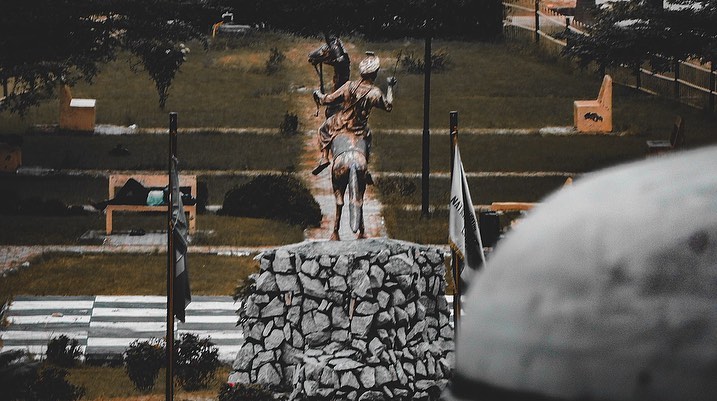The legendary Queen Amina was referred to as the fierce warrior queen in Kaduna State, particularly in Zaria, the old Kingdom of Zazzau. Thus, Amina, daughter of Nikatau, is still honored today in traditional Hausa praise songs as “A woman as capable as a man that was able to lead men to war,” due to her involvement in leading men to fight in Zaria, particularly during the 15th and 16th centuries. King Nikatau, the 22nd king of Zazzau, and Queen Bakwa Turunku (reigned 1536–c. 1566) welcomed young Amina into the world in the middle of the sixteenth century CE. Early in the 20th century, the British gave the present-day city of Zaria (Kaduna State) its nickname in honor of her younger sister, Zaria.
According to history, Amina was her grandfather’s favorite and grew up in his court. He carried her and gave her detailed military and political orders while he was in court. As a result, when Amina turned sixteen, she was given forty female slaves and given the title of Magajiya, or heir apparent (kuyanga). Many men have wooed Amina since she was a small child.
After Amina’s parents died in or around 1566, her brother eventually took the crown of Zazzau. Amina had made a name for herself in the military and was now regarded as a “leading fighter in her brother’s cavalry.” After her brother Karami passed away in 1576, Amina became the first female queen. But Daura, Kano, Gobir, Katsina, Rano, and Garun Gabas were the other six initial Hausa states (Hausa Bakwai). Zazzau was one of these prehistoric states as a result. Before Amina came to the throne, Zazzau was one of these largest states. It also provided Arab dealers with the majority of their slave supply for the slave markets in Katsina and Kano. Three months after becoming queen, Amina began a 34-year battle with her neighbors in an attempt to expand Zazzau territory. Her army, consisting of 1,000 cavalrymen and 20,000-foot soldiers, was formidable and well-trained. In one of her opening statements, she even called on her people to “resharpen their guns.” She conquered enormous tracts of land all the way to Kwararafa.
The two objectives of Amina’s conquests upon taking office were the extension of Zazzau beyond its original limits and the reduction of conquered towns to vassal status. Zaria became the commercial center of southern Hausaland as a result of Amina’s kingdom expanding, connecting the established east-to-west trans-Saharan axis and guaranteeing the region’s prosperity. As tribute, Amina gave the people of the area an unprecedented amount of money: forty eunuchs and 10,000 kola nuts. With the help of gold, slaves, and new crops, she expanded her nation’s wealth and influence. Amina’s people were expert metalworkers, so she equipped her troops with metal armor like chain mail and iron helmets.

The resilient mud walls of the city, which served as the model for defenses employed in all Hausa states, are also attributed to Amina. She built many of these defenses, which were known as “Amina’s walls” or ganuwar Amina, around the numerous cities she captured. Many of these obstacles still exist today. Therefore, these walls built by Queen Amina of Zaria served as an enduring memory of her glorious leadership in addition to protecting Hausa’s marketplaces from invaders approaching from the south. According to history, Queen Amina had a transient husband rather than being wedded.
According to another record, she had a new partner in each town she went to, and they were doomed to meet their depressing end early each morning.
The exact circumstances behind Amina’s death are unknown. Research indicates that she was reported to have died in Attaagar. The kingdom of Zazzau was the biggest of the Hausa kingdoms due to the size of Bauchi’s territory. Amina died at Atagara, near present-day Idah, because at the time of her death she had extended the bounds of Zazzau south of the confluence of the Niger and Benue. But there are a lot of contradictory details about her death.
For instance, numerous authors have written that she died at Vom Jos, despite the fact that certain historians maintain she died in Atagara, the modern-day Idah. The second story told of her meeting a wealthy Arabian prince who traveled across the desert to be with her after learning of her popularity. After spending the night with her, he fled into the desert before sunrise fearing that Amina might assassinate the Arabian Prince who had seen her in her undressed state. It was rumored that the Queen lost her mind when she realized a man would survive to witness her in her underwear and discuss it. When the agony of having the affair made public became too much for her, she committed suicide. Whichever of these tales is true, Queen Amina’s role as a conqueror will go on on forever in the annals of history.
Her accomplishments up to this day can be observed throughout Zaria, an ancient village, and even in the hallways of the seven original Hausa states. The actions of Queen Amina gave modern “feminism” a more forceful connotation, establishing the ideal balance and providing chances for women to take charge of their lives and accomplish anything they set their minds to.

